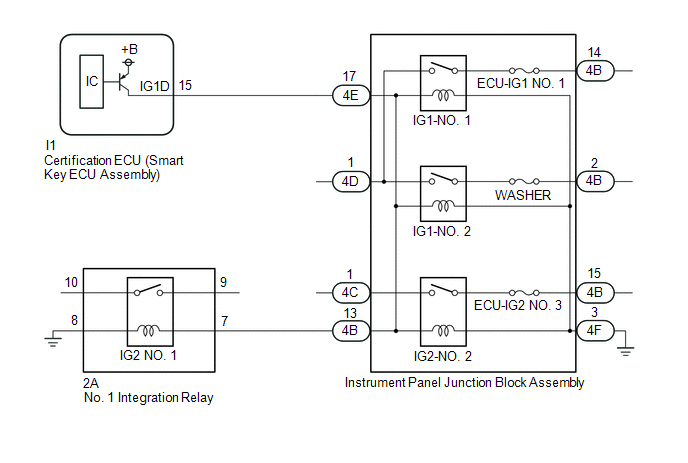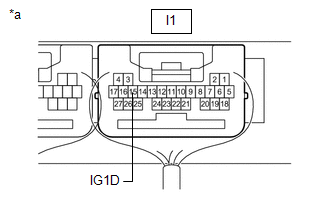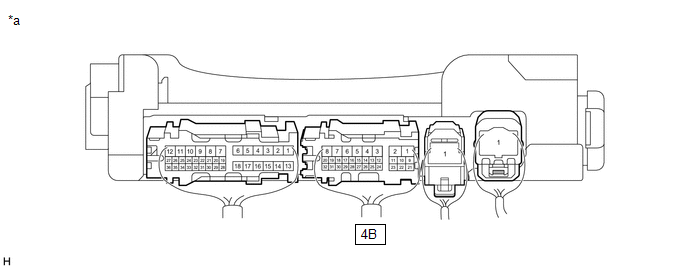|
Last Modified: 05-13-2024 |
6.11:8.1.0 |
Doc ID: RM100000001H8DW |
|
Model Year Start: 2020 |
Model: Corolla |
Prod Date Range: [01/2019 - 09/2022] |
|
Title: THEFT DETERRENT / KEYLESS ENTRY: SMART KEY SYSTEM (for Start Function, HV Model): Power Source Mode does not Change to ON (IG); 2020 - 2022 MY Corolla Corolla HV [01/2019 - 09/2022] |
|
Power Source Mode does not Change to ON (IG)
|
DESCRIPTION
If the power switch is pressed with the electrical key transmitter sub-assembly in the cabin, the certification ECU (smart key ECU assembly) receives a signal and changes the power source mode.
Related Data List and Active Test Items
|
Problem Symptom
|
Data List and Active Test
|
|
Power source mode does not change to on (IG) but does change to on (ACC)
|
Power Source Control
-
Power Supply Condition
-
IG Relay Monitor (Inside)
-
IG Relay Monitor (Outside)
-
IG Circuit
|
WIRING DIAGRAM

CAUTION / NOTICE / HINT
NOTICE:
-
When using the Techstream with the power switch off, connect the Techstream to the DLC3 and turn a courtesy light switch on and off at intervals of 1.5 seconds or less until communication between the Techstream and the vehicle begins. Then select the vehicle type under manual mode and enter the following menus Body Electrical Smart Key. While using the Techstream, periodically turn a courtesy light switch on and off at intervals of 1.5 seconds or less to maintain communication between the Techstream and the vehicle.
-
The smart key system (for Start Function) uses the LIN communication system and CAN communication system. Inspect the communication function by following How to Proceed with Troubleshooting. Troubleshoot the smart key system (for Start Function) after confirming that the communication systems are functioning properly.
Click here
![2020 - 2022 MY Corolla Corolla HV [01/2019 - 09/2022]; THEFT DETERRENT / KEYLESS ENTRY: SMART KEY SYSTEM (for Start Function, HV Model): HOW TO PROCEED WITH TROUBLESHOOTING](/t3Portal/stylegraphics/info.gif)
-
Make sure that no DTCs are output. If any DTCs are output, proceed to Diagnostic Trouble Code Chart.
-
If the smart key system (for Start Function) has been disabled, enable the system before performing troubleshooting.
Click here
![2020 - 2022 MY Corolla Corolla HV [01/2019 - 09/2022]; THEFT DETERRENT / KEYLESS ENTRY: SMART KEY SYSTEM (for Start Function, HV Model): CUSTOMIZE PARAMETERS](/t3Portal/stylegraphics/info.gif)
-
Inspect the fuses for circuits related to this system before performing the following procedure.
-
Before replacing the certification ECU (smart key ECU assembly), refer to Registration.
Click here
![2020 MY Corolla Corolla HV [01/2019 - 04/2020]; THEFT DETERRENT / KEYLESS ENTRY: SMART KEY SYSTEM (for Start Function, HV Model): REGISTRATION](/t3Portal/stylegraphics/info.gif)
![2021 - 2022 MY Corolla Corolla HV [04/2020 - 09/2022]; THEFT DETERRENT / KEYLESS ENTRY: SMART KEY SYSTEM (for Start Function, HV Model): REGISTRATION](/t3Portal/stylegraphics/info.gif)
-
After completing repairs, confirm that the problem does not recur.
-
After performing repairs, confirm that no DTCs are output by performing "DTC Output Confirmation Operation."
HINT:
-
If interior verification is unsuccessful, Operation History may be stored.
-
If Operation History has been stored, refer to the Operation History List to determine the detection conditions and narrow down trouble areas.
Body Electrical > Smart Key > Utility
|
Tester Display
|
|
Operation History
|
PROCEDURE
|
1.
|
CHECK POWER SOURCE MODE
|
(a) Get into the vehicle while carrying the electrical key transmitter sub-assembly that has already been registered.
(b) Move the shift lever to P.
(c) Press the power switch with the brake pedal released and check that the power source mode changes.
Click here
![2020 MY Corolla Corolla HV [01/2019 - 04/2020]; THEFT DETERRENT / KEYLESS ENTRY: SMART KEY SYSTEM (for Start Function, HV Model): OPERATION CHECK](/t3Portal/stylegraphics/info.gif)
![2021 - 2022 MY Corolla Corolla HV [04/2020 - 09/2022]; THEFT DETERRENT / KEYLESS ENTRY: SMART KEY SYSTEM (for Start Function, HV Model): OPERATION CHECK](/t3Portal/stylegraphics/info.gif)
|
Result
|
Proceed to
|
|
Power source mode cannot be changed
|
A
|
|
Power source mode can be changed
|
B
|
| B |

|
CHECK OPERATION HISTORY
|
|
A
|

|
|
(a) Using the Techstream, check for certification ECU (smart key ECU assembly) DTCs.
Body Electrical > Power Source Control > Trouble Codes
Body Electrical > Smart Key > Trouble Codes
|
Result
|
Proceed to
|
|
DTCs are not output
|
A
|
|
Smart key system (for Start Function) DTCs are output
|
B
|
|
A
|

|
|
|
3.
|
CHECK CERTIFICATION ECU (SMART KEY ECU ASSEMBLY)
|
|
(a) Measure the voltage according to the value(s) in the table below.
Standard Voltage:
|
Tester Connection
|
Condition
|
Specified Condition
|
|
I1-15 (IG1D) - Body ground
|
Power switch on (ACC) → Power switch on (IG)
|
1 V or less → 9 V or higher
|
|

|
|
*a
|
Component with harness connected
(Certification ECU (Smart Key ECU Assembly))
|
|
|
|
OK
|

|
|
|
4.
|
CHECK HARNESS AND CONNECTOR (CERTIFICATION ECU (SMART KEY ECU ASSEMBLY) - INSTRUMENT PANEL JUNCTION BLOCK ASSEMBLY)
|
(a) Disconnect the I1 certification ECU (smart key ECU assembly) connector.
(b) Disconnect the 4C, 4D, 4E and 4F instrument panel junction block assembly connectors.
(c) Measure the resistance according to the value(s) in the table below.
Standard Resistance:
|
Tester Connection
|
Condition
|
Specified Condition
|
|
I1-15 (IG1D) - 4E-17
|
Always
|
Below 1 Ω
|
|
4F-3 - Body ground
|
Always
|
Below 1 Ω
|
|
I1-15 (IG1D) or 4E-17 - Other terminals and body ground
|
Always
|
10 kΩ or higher
|
(d) Measure the voltage according to the value(s) in the table below.
Standard Voltage:
|
Tester Connection
|
Condition
|
Specified Condition
|
|
4D-1 - Body ground
|
Power switch off
|
11 to 14 V
|
|
4C-1 - Body ground
|
Power switch off
|
11 to 14 V
|
| NG |

|
REPAIR OR REPLACE HARNESS OR CONNECTOR
|
|
OK
|

|
|
|
5.
|
CHECK INSTRUMENT PANEL JUNCTION BLOCK ASSEMBLY (IG1-NO. 1, IG1-NO. 2, IG2-NO. 2 RELAY)
|
(a) Remove the instrument panel junction block assembly.
Click here
![2020 MY Corolla Corolla Hatchback Corolla HV GR Corolla [01/2019 - 03/2019]; POWER DISTRIBUTION: MAIN BODY ECU: REMOVAL](/t3Portal/stylegraphics/info.gif)
![2020 - 2022 MY Corolla Corolla Hatchback Corolla HV GR Corolla [03/2019 - 09/2022]; POWER DISTRIBUTION: MAIN BODY ECU: REMOVAL](/t3Portal/stylegraphics/info.gif)
(b) Connect all of the instrument panel junction block assembly connectors.
(c) Connect the I1 certification ECU (smart key ECU assembly) connector.
(d) Measure the voltage according to the value(s) in the table below.

|
*a
|
Component with harness connected
(Instrument Panel Junction Block Assembly)
|
-
|
-
|
Standard Voltage:
|
Tester Connection
|
Condition
|
Specified Condition
|
|
4B-14 - Body ground
|
Power switch on (IG)
|
11 to 14 V
|
|
4B-2 - Body ground
|
Power switch on (IG)
|
11 to 14 V
|
|
4B-15 - Body ground
|
Power switch on (IG)
|
11 to 14 V
|
|
4B-13 - Body ground
|
Power switch on (IG)
|
11 to 14 V
|
|
OK
|

|
|
|
6.
|
INSPECT NO.1 INTEGRATION RELAY
|
(a) Remove the No. 1 integration relay.
Click here
![2020 MY Corolla Corolla Hatchback Corolla HV GR Corolla [01/2019 - 03/2019]; POWER DISTRIBUTION: INTEGRATION RELAY: REMOVAL](/t3Portal/stylegraphics/info.gif)
![2020 - 2022 MY Corolla Corolla Hatchback Corolla HV GR Corolla [03/2019 - 09/2022]; POWER DISTRIBUTION: INTEGRATION RELAY: REMOVAL](/t3Portal/stylegraphics/info.gif)
(b) Inspect the No. 1 integration relay.
Click here
![2020 - 2022 MY Corolla Corolla Hatchback Corolla HV GR Corolla [01/2019 - 09/2022]; POWER DISTRIBUTION: INTEGRATION RELAY: INSPECTION](/t3Portal/stylegraphics/info.gif)
|
OK
|

|
|
|
7.
|
CHECK HARNESS AND CONNECTOR (INSTRUMENT PANEL JUNCTION BLOCK ASSEMBLY - NO.1 INTEGRATION RELAY)
|
(a) Disconnect the 2A No. 1 integration relay connector.
(b) Disconnect the 4B instrument panel junction block assembly connector.
(c) Measure the resistance according to the value(s) in the table below.
Standard Resistance:
|
Tester Connection
|
Condition
|
Specified Condition
|
|
4B-13 - 2A-7
|
Always
|
Below 1 Ω
|
|
2A-8 - Body ground
|
Always
|
Below 1 Ω
|
|
4B-13 or 2A-7 - Other terminals and body ground
|
Always
|
10 kΩ or higher
|
| NG |

|
REPAIR OR REPLACE HARNESS OR CONNECTOR
|
|